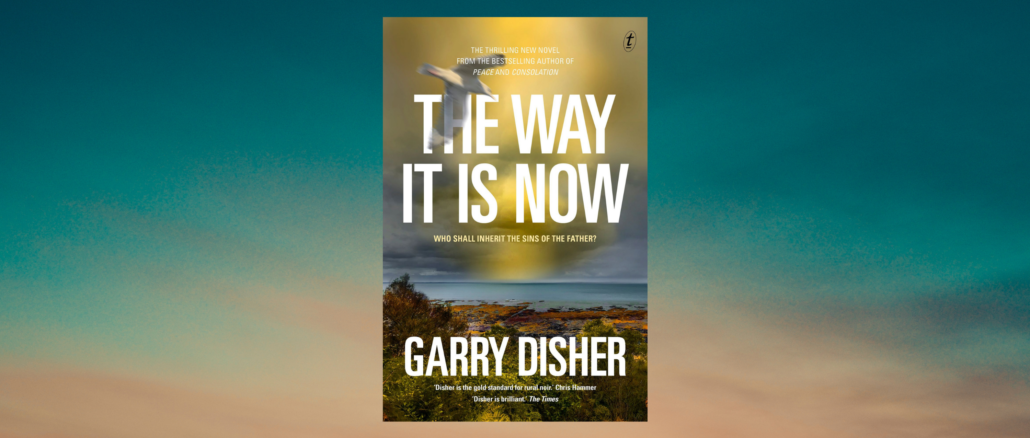
Some 38 000 Australians go missing each year; ninety-nine percent of these people are located within a year with the assistance of the public. In “The Way It Is Now”, the murkily menacing new crime novel by prolific Australian author Garry Disher, a wife and mother, Rose Deravin, goes missing in a disturbingly perplexing fashion – and is still missing twenty years later.
Our main protagonist in this scorchingly spellbinding novel, Charlie Deravin (a Detective Senior Constable in the Victorian police force, and the dutifully attentive son of Rose) finds himself in the horrifically unenviable position of having a mother who has been missing for twenty painfully scarring years, and is presumed dead.
The brief beginning of the novel (that takes place in January 2000),sets the scene for us in the idyllic, yet lackadaisical, beach suburb of Menlo Beach on the Mornington Peninsula. Charlie grew up in the family home, an old “shack”, at 5 Tidepool Street at Menlo Beach. Charlie’s father, Detective Sergeant Rhys Deravin, bought the property in the late 1970s. Six policeman in total resided in Menlo Beach back in the day, and there entailed for the police families “Booze-soaked barbecues and beach cricket, wrestling on the lawn” amongst other shenanigans. These larger-than-life ‘cops’ in the Menlo Beach locale were “Guys with big natures and a black intensity if you caught them unguarded”.
After an exploratory beginning of the novel, we as readers find ourselves harshly propelled forward to December 2019, through to January 2020. In this latter span of time, Charlie finds himself living alone in the Tidepool Street modest house that he and his younger brother, Liam, grew up in, along with their salubrious parents. It is in this December through to January time period that Charlie finds himself unceremoniously suspended from his job with “the police sex-crimes unit” (and also separated from his wife), after he has shoved a superior, Inspector Allardyce, after Allardyce cuttingly and rudely provoked Charlie at work, by mentioning Charlie’s girlfriend, Anna, in a crudely menacing way.
As part of his suspension (with pay), Charlie is required to routinely have laborious sessions with a meticulous female therapist, Dr Fiske, who is a no-nonsense and unflappable inquisitor. Additionally, Charlie has had no satisfaction from the police tasked with investigating Rose’s disappearance, so has launched himself into questioning people he believes are suspects, or persons of interest. “Charlie’s police-work mantra was: Believe no one, accept nothing, until you had proof otherwise”, and Charlie still adopts this ideology as he spreads himself round the place following what he thinks are leads in Rose’s murder case.
Two of the policeman from back in the day in Menlo Beach, Mark Valente (Rhys’s former partner in “Major Crimes”) and Noel Saltash, are still residents at Menlo beach, and keen daily beach-goers, and Charlie regularly encounters them on his jaunts to the beach.
Charlie’s is brutally shocked when his mother’s and a young boy’s, Billy Saul’s (aged nine), bodies are found buried together under a concrete slab in Longstaff Street in nearby Swanage; the street in which Rose used to live. Billy Saul went missing around the same time as Rose.
Charlie’s father, Rhys Deravin, has “always been a suspect: He was questioned and cleared back then (in 2000) but the stink never left him”.
Charlie has always kept an open mind as to whether Rhys murdered Rose or not, but deep down nonchalantly refuses to believe Rhys capable of murdering Rose, let alone a child. Liam on the other hand has consistently held on to the murky belief that Rhys murdered Rose, and never appears to waver from this position.
Has Rhys expertly been covering his tracks for twenty years? Why were Rose’s and Billy’s bodies found together? Were the characters at Menlo Beach from Charlie’s youth the epitome of Australian larrikinism, as Charlie always perceived them to be, or were there darker forces at work in the seemingly sublime beachside locale?
Garry Disher writes with undeniable intelligence and believability. As I progressed in my reading of this searingly superb novel, the pages were being turned by me faster and faster. All characters resonated as being truthfully portrayed in a way that had me feeling I almost knew them deep down. Or did I?
“The Way It Is Now” will have you, as it did me, guessing until the very end of this superbly written and quintessentially Australian story. I highly recommend this book for an absorbing and mesmerising holiday read.


Leave a Reply